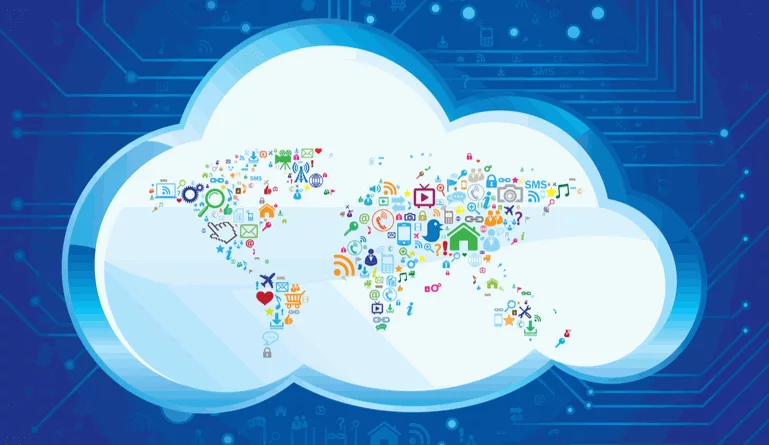With the recent advancements in technology over the past few years, the world of technology has been familiarizing itself with the concept of cloud computing. The reason for this is pretty straightforward. The benefits that come with cloud computing architecture has caused several organizations, both large and small, to leverage the opportunities abundant in cloud computing.
These benefits vary from easy accessibility, storage, flexibility, and sharing. In fact, households are tapping into these benefits of cloud computing on a day-to-day basis. This is because services like Spotify, Skype, OneDrive, and Google Docs are provided to us through virtual networks.
What is Cloud Computing Architecture?
Cloud computing architecture can be defined as the different components that have been designed, in terms of applications, software capabilities, databases, etc. to maximize the functions of cloud resources in order to provide long-lasting business solutions.
Why Use Cloud Computing Architecture?
-
Cost-Effectiveness
This is one of the most important reasons why you should make use of cloud computing architecture. This is because cloud computing does not require any physical hardware investments. Consequently, this helps you to save significant capital costs.
In addition, there is no need to hire trained personnel for the maintenance of the hardware. Everything that deals with the purchasing and maintenance of your equipment is handled by the cloud service provider.
-
Access to The Latest Technology
Another essential reason why you need cloud computing architecture is to gain a competitive edge over your competitors. It enables you to get the most recent and modern tech applications whenever you need them. You would not have to spend any extra money or time on installation processes.
-
Fast Connectivity
With cloud computing, you are empowered to quickly deploy your service in lesser chicks. The consequent effect of quicker deployment is the ability for you to access the necessary resources for your system within fewer minutes.
-
Data Backup and Restoration
The moment the data is stored in a cloud storage architecture, it is very easy to backup and recovers any lost data without any hassles. This equally helps to save time that would have otherwise been spent on the time-taking process.
-
Systematic Integration of Software
Software integration is something that automatically takes place in the cloud. Hence, you would not have to put in any extra effort in a bid to customize and integrate your applications according to your preferences.
-
Reliability
This is another good reason why you need cloud computing. In this regard, you can always rely on cloud computing architecture for instant updates about any changes or modifications.
-
Remoteness
If you desire to work remotely from home, then cloud computing architecture should be a priority for you. This is because it allows employees who are working at remote locations to easily access all they need on the cloud services. So far as there is Internet connectivity, then mobility is guaranteed.
-
Unlimited Storage
A significant feature of the cloud is that it provides almost limitless storage capacity. Whenever the need arises, you can always quickly expand your storage capacity with very nominal monthly charges.
-
Enhancement of Collaborative Efforts
Lastly, you need cloud computing architecture if you want your employees who are positioned in different locations to work together and collaborate in a highly comfortable and secure manner. With cloud computing architecture, secured sharing and receiving valuable data is possible.
-
Scalability and Flexibility
Cloud computing architecture is appropriate for businesses that have a growth or fluctuation bandwidth demand. This is because it makes it very easy for businesses to scale up their cloud capacity by simply modifying their usage plan. In like manner, if the business desires to scale down, the cloud-based service provider can also make this possible.
On the other hand, the degree of flexibility that cloud computing architecture provides a business with gives it a competitive edge over other competitors. No wonder Gartner Study has ranked IT directors and CIOs as a top driver for cloud adoption.
-
IoT Readiness
Cloud computing architecture is known to influence brands to embrace the IoT age more swiftly. This is quite vital since almost everyone uses a smartphone device. Therefore, by embracing the cloud, businesses are enabled to better communicate with their customers or even internal staff on any form of platform. This consequently results in an increased capacity to provide a more customized experience.
Architectures of Cloud Computing have the following characteristics:
The following are the characteristics of cloud computing architecture:
- Flexibility and Scalability
- Immediate sharing of resources such as database, software, and hardware, etc.
- Multiple provisioning
- Demanding service, i.e. ‘Service on Demand’, most often with a billing and monitoring platform.
- Virtual resources
- Administration of programs just like via WS API.
( Also Read: What Is Cloud Computing? A Complete Guide )
Four Layers of Cloud Computing Architecture
-
The Hardware Layer
These strata are responsible for handling the physical assets of the cloud. These physical assets could include switches, servers, routers, cooling systems, and power.
-
The Infrastructure Layer
These strata are also referred to as the virtualization strata. The infrastructure strata create a pool of storage capacity and computing resources by dividing the physical resources. This division is done by utilizing virtualization technologies such as VMware and KVM.
-
The Platform Layer
The platform strata are based on top of the infrastructure strata. The composition of this strata is made up of operating systems and the required structures.
-
The Application Layer
These strata consist of real cloud provisions. These provisions are utilized for Web Services, Business Applications, and Multimedia Services
What are the Components of Cloud Computing Architecture?
- Front-end platform: This platform consists of mobile devices, small clients, and big clients.
- Back-end platform: It comprises of storage and servers.
- Cloud-based delivery: This refers to anything that the cloud service provider is offering to the end-users from the cloud. This is done through some platforms, software, and infrastructure.
What You Should Know About Front end Architecture
Everything that the end-user interacts with is comprised of the front end platform. It is a wider collection of different sub-components that collaborate to provide the user interface. The front-end architecture makes up an important part of how the end-user connects to the cloud computing architecture. This architecture consists of components such as web applications, local networks, and web browsers.
Main Front end Architecture
Below are certain components that comprise the main front-end architecture:
-
Software
The software component in the front end architecture is the software that operates on the user’s side. The software component in the front end architecture basically makes up the client-end applications or browsers.
-
User Interface
These components refer to all the elements that the end-user access in order to process requests or execute any function on the Cloud. Examples of common cloud-based user interfaces include Gmail, Google Docs, etc.
-
Client System or Network
This is an important part of the front end platform. It refers to the hardware at the end user’s side. This component can be any input device or PC. When it comes to cloud computing architecture, the client-side system does not need any super ability in order to process the heavy data. The cloud has the capacity to store the whole heavy data and also process it.
What You Should Know About Back end Architecture
It is the duty of the back end architecture to support the front-end platform. It consists of the hardware and storage components and they are both located on a remote server. It is the function of the cloud service provider to oversee and manage the back-end cloud platform.
Typically, the back end cloud architecture should usually be robust. This is because it contains the entire infrastructure on the cloud.
Components of Back end Architecture
Below are the basic components of back-end cloud architecture:
-
Storage
The data of a cloud application resides in the Cloud storage. Different Cloud service providers offer different data storage. One thing they all have in common is a dedicated section for cloud storage. Examples of storage are hard drives, Intel Orange Optane DC Persistent storage, solid-state drives, etc.
The hard drives in the server bays form storage in the cloud backbend architecture. Particularly in a cloud computing architecture, the software divides the drives according to the needs of the OS in the cloud. This is done in order to operate a plethora of services.
-
Security
This is a crucial aspect of any cloud computing architecture. Security structures are developed by keeping the debugging process in mind. Debugging would not be any much of a problem when the need arises.
In order to make sure security is guaranteed in a cloud computing system, the first thing to do is constant storage backup. Thereafter, you can affect virtual firewalls and other necessary elements that are critical in cloud security architecture.
-
Cloud Runtime
This concept refers to where the services run. It is synonymous with a cloud operating system where virtualization-related technology is utilized. The benefit of virtualization on cloud architecture is that it enables multiple runtimes on the same server.
When you utilize virtualization software to create runtimes, they are called Hypervisors. Examples of top hypervisors are VMWare Fusion, Oracle VM for x86, and Oracle Virtual Box, etc.
-
Application
This is a prominent aspect of the back-end architecture. It entails the user interface that the back-end platform provides the end-user with, in order to send queries. This aspect of the back-end platform is responsible for addressing the client’s demands and needs.
-
Infrastructure
This refers to the system that directs all cloud software services. The workloads of the clients will always determine the infrastructure models. Examples of the infrastructure are Graphics Processing Unit (GPU), the CPU, Motherboard, accelerator cards, network cards, etc.
-
Service
The whole back-end cloud architecture receives utility from this essential aspect of the back-end cloud architecture. It is the function of the Service to manage every task that operates on the cloud computing architecture.
Some of the cloud services include web services, storage, and app development environment. It is necessary to also mention that service can carry out a vast range of functions on the cloud runtime.
-
Management
If the function of the management software to distribute certain resources to certain tasks. It is tasked with the smooth operation of any cloud architecture without any errors.
In technical jurisdiction, management is the ‘middleware’. This means that it harmonizes between the front-end and back-end platforms in a cloud computing architecture.
-
Internet
The Internet is an avenue through which front end and back end platforms can interact and communicate with each other.
What Is Cloud-based Delivery?
As earlier expounded, cloud-based delivery is any form of operation or function that a provider can offer through infrastructure, software, and platforms.
Therefore, if your business uses Google Drive or Office 365, then you are making use of cloud-based delivery. In addition, other cloud-based delivery subscriptions like Platform-as-a-Service (PaaS), Infrastructure-as-a-Service (IaaS), etc., are made possible.
These are just a few of the different subscriptions an individual or organization can purchase in order to use the software that is commonly referred to as Software-as-a-Service (SaaS). This is all thanks to technological innovations like virtualization and hypervisors.
You should know that Cloud-based delivery can be done both privately and publicly through the Internet. In fact, it can be retained within an organization’s network when delivered over an intranet. A combination of both is also possible.
Software as a Service (SaaS)
This cloud computing service is also referred to as cloud application services. This delivery model involves the provision of cloud computing services through authorized software or subscription.
It is not necessary for the end-users to purchase or install any hardware for this cloud-based delivery model in their respective locations. This is because in most cases, SaaS applications operate directly via the web browser. This consequently eliminates the need to download or install the applications.
Below are some popular examples of SaaS:
- Google Apps
- Salesforce Dropbox
- Slack
- HubSpot
- Cisco WebEx
Platform as a Service (PaaS)
Platform as a Service can also be referred to as cloud platform services. In a way, it possesses certain similarities with SaaS. However, the point of divergence is that PaaS offers a platform for the creation of software. On the other hand, SaaS enables access to software over the Internet without the requirement of any platform.
The essence of PaaS as a cloud-based delivery model is to provide the end-users with the opportunity to create, operate, and also manage apps on the cloud computing architecture. In this delivery model, a third-party service provider organizes the hardware and software components.
Examples of PaaS are listed below:
- Windows Azure
- Force.com
- Magento Commerce Cloud
- OpenShift
Infrastructure as a Service (IaaS)
It can also be referred to as Cloud Infrastructure Services. Here, this cloud-based delivery model supports computer hardware such as storage, data center space, and networking technology as a service. It further helps to deliver virtualization technology and operating system. It is the responsibility of Infrastructure as a Service to manage middleware, application data, and runtime environments.
Examples of Infrastructure as a Service Includes:
- Amazon Web Services (AWS) EC2
- Google Compute Engine (GCE)
- Cisco Metapod
What is a Cloud Services Network?
The cloud services network enables the end-user to develop a data center or to access the service provider’s data center. This will help the end-user to have on-demand access to different resources such as services, server, application, network, and storage.
Final Thoughts
In all, it becomes very conspicuous that the architecture of cloud computing provides a plethora of advantages to businesses. The adoption and implementation of cloud computing architecture will give businesses a higher competitive power in terms of increased productivity and lower costs, etc.
Therefore, it is essential for ambitious organizations that seek to succeed in the post-IoT era to leverage on the opportunities abundant in cloud computing architecture. It is time to forsake the on-premise hosting behind and become very accessible through the most recent IoTs that are available on the clouds.






